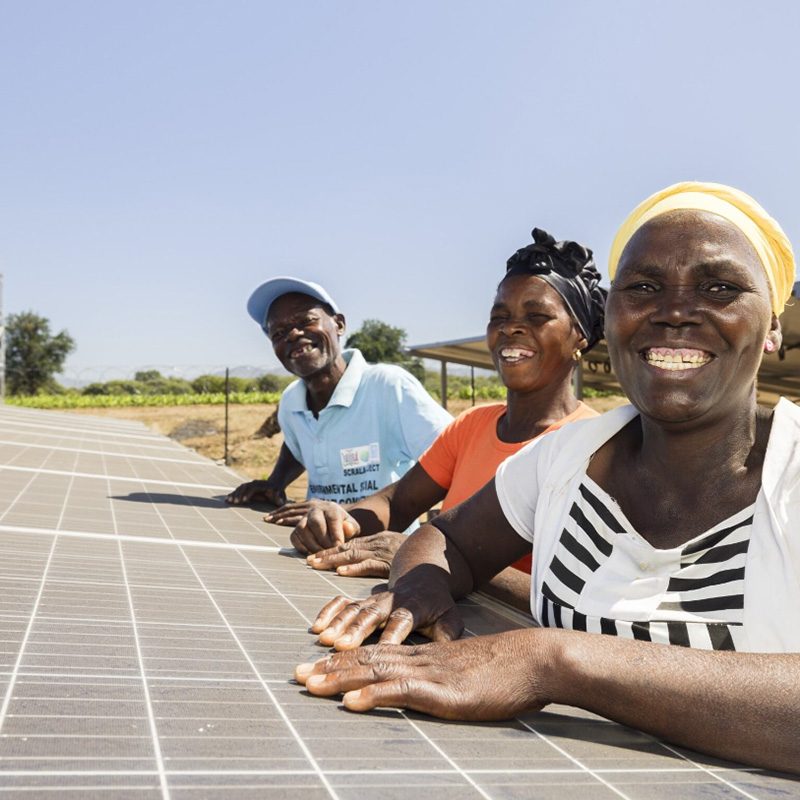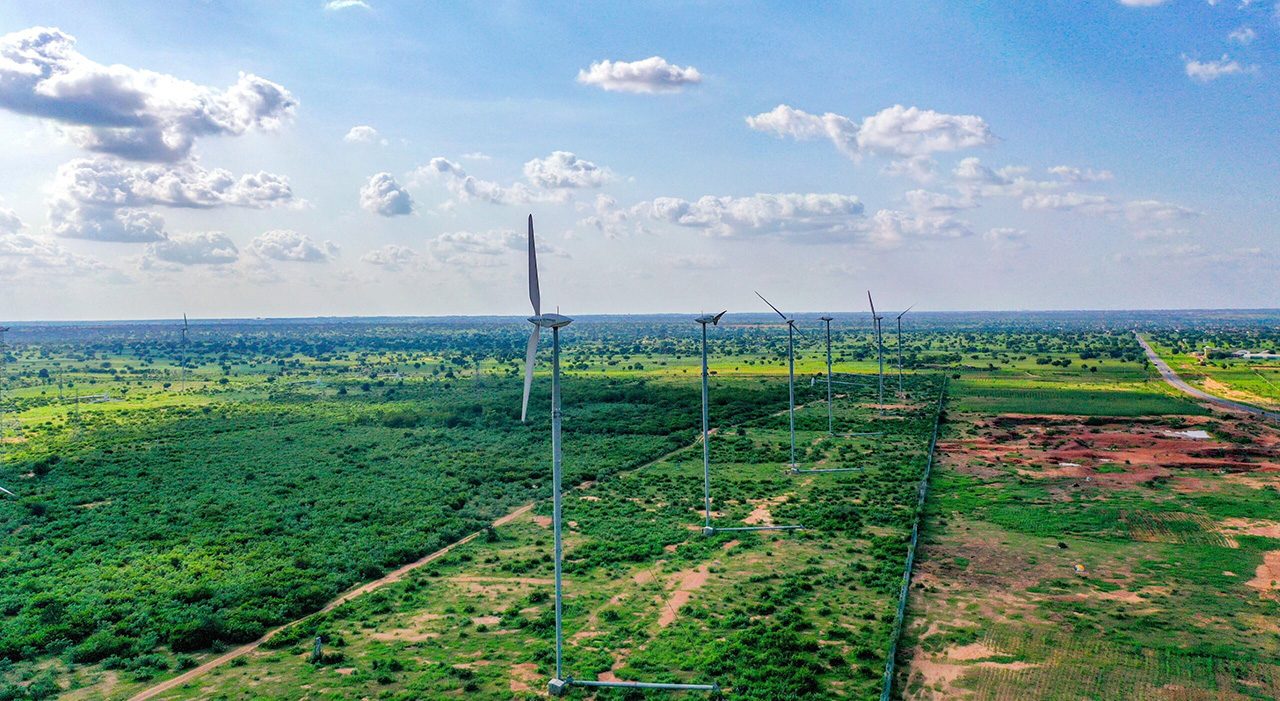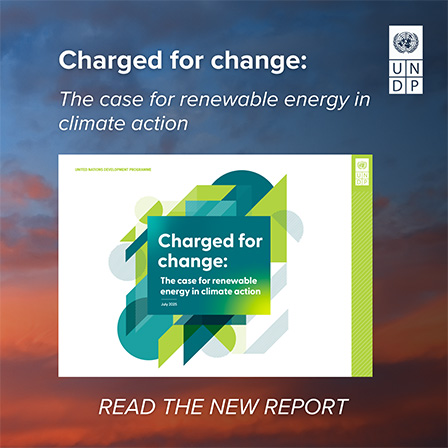
This new report by the United Nations Development Programme (UNDP), the University of Denver’s Pardee Institute and Octopus Energy explores how quantitative and time-bound renewable energy targets, when paired with inclusive policies, can unlock a triple win: accelerating emissions reduction, driving economic growth and delivering real social benefits.

Photo: UNDP Zambia
A balancing act for a safe future
Decades of reliance on fossil fuels have driven various aspects of human development - but at a steep cost to our climate. Today, the world faces a dual challenge: to equitably advance human well-being while also mitigating the devastating environmental impacts of fossil-fuel-driven growth. Achieving this balance between meeting human needs and preserving global ecological systems requires a new direction that aligns renewable energy targets with inclusive policy measures to support a just and sustainable energy transition.
With a sustainable energy portfolio spanning over 130 countries, UNDP's on-the-ground experience shows that renewables are more than just megawatts - they are a foundation for development. Clean energy is a catalytic driver of development, powering healthcare, education, while also providing a solution to the more than 80 percent of global emissions linked to energy and industrial processes. From electrifying schools and clinics in crisis settings like Afghanistan and Yemen, to supporting electric mobility subsidy reforms in Paraguay, and to advancing climate-smart agriculture in Sri Lanka and Zambia, UNDP is helping governments translate energy transition goals into real outcomes that matter for people.
As UNDP's work in fragile and developing contexts demonstrates, inclusive energy transitions require more than just technology. A full ecosystem of enabling policies and regulation, financing, institutional and human capacity and community engagement is needed to make these transitions a success. In countries like Moldova, where UNDP has helped deploy smart meters to over 18,000 homes, digital infrastructure is accelerating both energy efficiency and public trust. In Papua New Guinea and Vanuatu, decentralized solar energy supported by UNDP is powering over 1,000 remote households and enabling development in communities most vulnerable to climate change.
The energy transition is underway, but it’s happening faster in some areas than others
Meeting the goals of the Paris Agreement requires a transformation of the global energy system. As outlined in the decision from the first Global Stocktake and the UAE consensus of COP28 in Dubai, this means tripling renewable energy capacity, doubling energy efficiency gains, and transitioning away from fossil fuels by 2030.
Realizing these pathways will rely on sustainable and inclusive finance and the deployment of renewable power, shifting energy systems away from fossil fuels. Clean energy investments are set to reach a record-breaking high of US $2.2 trillion in 2025, outpacing fossil fuels for a second year in a row. Similarly, renewable power capacity hit 4,448 GW in 2024, making up over 90 percent of all new power additions. This rapid growth is being driven by technological advances in solar, wind, and energy storage.
However, despite this progress, global growth in renewable energy capacity remains insufficient to meet the international goal to triple renewable energy capacity by 2030. Achieving this target would require global capacity to grow by 16.6 percent annually until 2030 – a pace the world is not currently on track to meet.
The disparity is even more pronounced for vulnerable nations: Small Island Developing States (SIDS), which are among the most exposed to climate impacts and often rely on fossil fuels for their energy, account for just 0.2 percent of global renewable capacity. Alarmingly, they added less new capacity in 2024 than in the previous year, underscoring persistent structural barriers.
All of this raises a critical question…
What if strong ambition on clean energy alone isn’t enough?
Ambitious renewable energy and energy efficiency targets and actions are widely recognized for their development benefits.
What if these targets were supported by broader policy measures that facilitate a just transition and progress on the Sustainable Development Goals (SDGs)? What would be the quantifiable benefits for both climate and development?
As UNDP, the Pardee Institute and Octopus Energy, we set out to explore these questions through a new collaborative study. As part of our research, we developed and simulated three distinct scenarios of future energy development, using the International Futures Model (IFs).
Scenario #1: The Base Case
This is the most likely path of renewable energy development based on current policies. This represents a business-as-usual trend whereby global ambition stagnates over time. In this scenario, the world’s dependence on fossil fuels remains moderately high by 2060 (over 50 percent of primary energy production).
Scenario #2: Achieving Renewable Acceleration (RA)
This scenario explores the implications of what would happen if the renewable energy transition accelerated in line with the Global Stocktake decision – which calls on countries to triple renewable energy, double energy efficiency and phase out fossil fuels. In this scenario, the world’s reliance on fossil fuels is much lower (12 percent of primary energy production).
Scenario #3: Achieving both Renewable Acceleration + SDG targets (RA+SDG)
The third scenario builds on the acceleration noted in Scenario #2, while also supporting system-wide SDG-aligned investments to improve outcomes in infrastructure, education, health and governance. As with the previous scenario, the world’s reliance on fossil fuels is much lower at 12 percent of primary energy production, but with the added benefit of amplified development outcomes across sectors.
Here are five takeaways from the study:
1. Tripling renewable capacity allows us to meet the world’s commitments on the Paris Agreement and the SDGs.
Scenarios 2 and 3 (RA and RA+SDG scenarios) significantly accelerate the deployment of renewable energy: they triple global capacity by 2030.
Global renewable capacity increases from 3,700 GW in 2024 to 10,500 GW by 2030 - a pace aligned with the global stocktake target of 11,000 GW needed to stay on track with the Paris Agreement.
By 2060, these shifts would allow the world to limit the rate of global warming to 1.8°C in the second scenario, and 1.5°C in the third scenario.
2. Early renewable investments can unlock $20 trillion in cumulative savings by 2060, as early investments in renewables reduce long-term energy cost savings and curb fossil fuel dependency.
Under the first scenario (the Base Case), renewable energy investments grow moderately, while fossil fuel spending continues well into the 2030s. The second and third scenarios demonstrate that meeting Paris-aligned goals will require a major scale-up whereby annual renewable investments must rise to $2.5–$3.4 trillion between 2024 and 2050, compared to just $1.8–$1.9 trillion in the Base Case.
Meanwhile, Scenarios 2 and 3 call for front-loaded capital investment, resulting in a 30–35 percent increase in renewable power spending by the 2040s and a nearly 50 percent decline in fossil fuel investments. The payoff is significant. By 2060, the third scenario delivers an estimated $20.4 trillion in cumulative savings — driven by $8.9 trillion in energy efficiency gains and $11.5 trillion from falling renewable costs.
3. The clean energy transition can drive inclusive economic growth.
Scenario #3 would increase GDP by 20 percent (up by $48 trillion relative to the base case) and increase average per capita income by $6,000.
4. Energy access and investment can lift millions out of poverty.
Under Scenario #3, the world lifts an additional 193 million people out of extreme poverty, helping close persistent inequality gaps. Scenario #3 fosters a virtuous cycle of development, one that increases energy access, advances human development, and bridges long-standing development gaps, especially in low- and middle-income countries.
5. Energy-enabled agriculture can boost yields in low- and middle-income countries by two to three times.
Access to energy creates perfect opportunities for agriculture, enabling efficient irrigation, cold chains and mechanization. As a result, in Scenario #3, we see that in low- and middle-income countries, agricultural yields increase by two to three times in low and middle-income countries, compared Scenario #1 (the Base Case).
What does this work look like on the ground?
When it comes to renewable energy, there is great potential for growth at the country level. To have a deeper understanding of the impacts of this study, we explored our scenarios in Ecuador, Indonesia, Nigeria, and Türkiye. Not surprisingly, what we found was that the third scenario shows similarly positive socio-economic outcomes at the national level.

Photo: UNDP Ecuador
Ecuador
In Ecuador, our modelled third scenario projects gains in productivity and livelihoods, universal electricity access, and elimination of extreme poverty at the national level. UNDP has been a key partner in supporting Ecuador’s energy transition, aligning national efforts with global climate goals. Through strategic collaboration with the government and stakeholders, UNDP has promoted the integration of renewable energy into the country’s energy matrix, helping to reduce dependence on fossil fuels and fostering a just and sustainable shift toward clean energy.
Through technical assistance and policy support, UNDP has strengthened institutional frameworks and aligned national development goals with climate commitments. A key example is its support for the development of Ecuador’s 2025 NDC, which prioritizes renewable energy, sustainable mobility and energy efficiency. As part of this technical support, two wind, three solar and two hydroelectric projects from Ecuador’s Electric Corporation CELEC EP have been included in the investment pipeline to seek financing through the Global Gateway initiative and the European Investment Bank.

Photo: UNDP Nigeria
Nigeria
Nigeria has recently taken a transformative and historic step, approving the Electricity Act, 2023. This has kickstarted significant efforts at both the federal and state level to address longstanding systemic challenges in the country’s energy sector. In a notable shift from a previously centralized system, subnational governments are now engaging more actively, with approximately 12 out of Nigeria’s 36 states moving to establish their own state electricity markets. This decentralized approach—that allows subnational state governments to manage electricity generation, transmission and distribution functions—has the potential to accelerate renewable energy adoption and unlock substantial socio-economic development opportunities in a country that faces one of the world's largest energy access deficits. Under Scenario #3, Nigeria could achieve universal clean cooking and electricity access, addressing the country’s energy poverty.
UNDP, alongside other partners, is working closely with government to support Nigeria’s energy transition. This includes support to the newly passed National Integrated Electricity Policy (NIEP), and preparation of its 2025 NDC submission, which includes energy as a key sector. Together, these processes are informing a clean energy future for Nigeria.
Summary of findings
By 2030, embedding strong renewable energy ambition into a development pathway aligned with the SDGs:
- Scenario #3 allows the world to achieve the call to action of the global stocktake on renewable energy and energy efficiency.
By 2060:
- Scenario #3 allows the world to achieve universal access to electricity and clean cooking.
And compared to Scenario #1 (the Base Case), we find Scenario #3 (RA+SDG) supports the following development gains:
- 193 million fewer people could live in extreme poverty,
- 142 million fewer people could face malnutrition, and
- 550 million more people would gain access to clean water and sanitation.
This is not just socially transformative, it’s also economically sound. While it requires upfront investment, this is money well spent, as the third scenario could result in:
- $20.4 trillion in cumulative savings by 2060 ($8.9 trillion from energy efficiency, $11.5 trillion from lower renewable energy costs).
- A substantial shift in capital as fossil fuel investment drops by nearly 50 percent while renewable energy investments increase by 30–35 percent by the 2040s.
The bottom line: A clean energy future is within reach, but we must choose it. By embedding renewable ambition into climate plans, and linking it to inclusive development, we can drive the transformation the world needs. This is not just about megawatts. It’s about changing lives, securing futures and creating a pathway to 1.5°C that delivers for everyone, everywhere.
Explore more of the data in detail here.
To learn more, download and explore our report and case-studies below.
Notes
All data is based on the International Futures model version 8.32.
These are illustrative scenarios intended to inform country strategies. The research does not model implementation dynamics, as these will vary based on country-specific contexts.
Energy production data is based on primary energy production data by source.
Citation
Sahadevan, D., Irfan, M. T., Luo, C., Moyer, J. D., Mason, C., & Beynon, E. (2025). Charged for change: The case for renewable energy in climate action. UNDP; Pardee Institute for International Futures; Octopus Energy.
